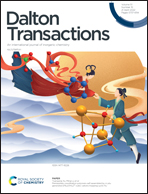Turn-on and blue-shift fluorescence sensor toward l-histidine based on stable CdII metal–organic framework with tetranuclear cluster units†
Abstract
A novel CdII-based two-fold interpenetrated metal–organic framework (MOF), namely {[Cd2(BTDB)2(4,4-bpy)]·DMF}n (JXUST-14), (H2BTDB = 4,4′-(benzo[c][1,2,5]thiadiazole-4,7-diyl)dibenzoic acid and 4,4-bpy = 4,4-bipyridine), has been prepared and characterized. Single-crystal structure determination reveals that JXUST-14 has a tetranuclear cluster based 6-connected pcu topological network with Schlafli symbol {412·63}. When soaked in common organic solvents and aqueous solutions with diverse pH values of 2–12 for 48 h, JXUST-14 remains stable. JXUST-14 is a highly selective and sensitive luminescent sensor for L-histidine (His) with a detection limit of 11.1 ppm. JXUST-14 is the first CdII-based MOF for the detection of His via turn-on and fluorescence blue-shift effects. Experimental study and theoretical calculation suggest that the sensing process can be mainly attributed to a charge transfer and energy transfer mechanism. More interestingly, LED lamps of JXUST-14 and JXUST-14@His were successfully developed, which endowed efficient sensitivity for His detection and thus provide great potential for future applications.



 Please wait while we load your content...
Please wait while we load your content...